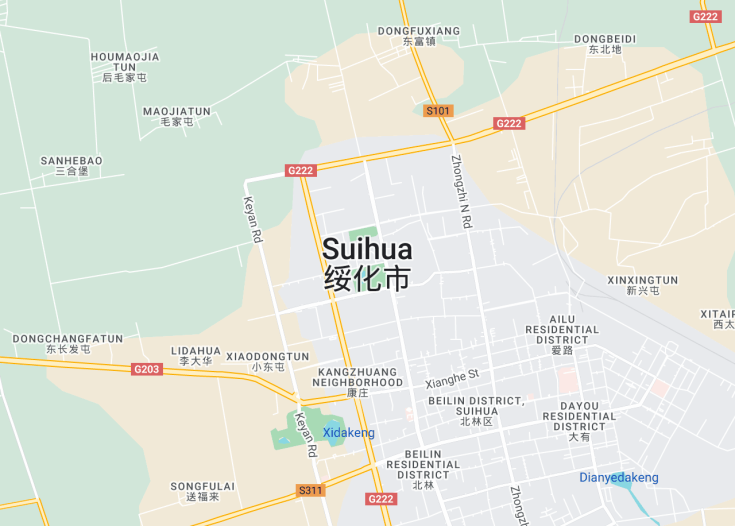Suihua, located in Heilongjiang Province of China, serves as a captivating portal to the northeastern charm of the country. Known for its rich agricultural heritage, Suihua offers expanses of lush farmland and a close connection to nature. The region is revered for its production of grains and is instrumental in supporting the food supply in China. Travelers will find Suihua appealing not only for its scenic landscapes but also for its cultural heritage, including traditional Russian influences, which manifest in the local architecture and cuisine. A trip to Suihua is an embrace of tranquility, rural beauty, and a warm, welcoming community.
For an authentic experience, visit during the harvest season in early autumn to see the golden wheat fields and partake in the local harvest festivals.
Consider exploring the lesser-known villages around Suihua to truly appreciate the traditional lifestyle and agricultural practices of this fertile region.
Top things to do & see in Suihua
Select the following sights and activities to discover best tickets and tours available in Suihua.
Suihua: Gateway to the North
| Country | China |
| Time in Suihua | GMT+8 |
| Language spoken | Mandarin |
| Population | 5,418,434 (Heilongjiang Provincial Bureau of Statistics, 2023) |
| Currency | Chinese Yuan (¥ / CNY) |
| Airports |
|
Suihua, located in Heilongjiang Province, China, serves as a crucial hub in the Northeast, connecting larger cities through its expansive transportation networks. The city lies in the fertile Songnen Plain, which makes it a significant agricultural center famous across China for its grains and soybeans. Over recent years, Suihua has also focused on expanding its industrial sectors, thereby diversifying its economic foundations.
Where is Suihua?
Situated in the northern part of Heilongjiang Province in China, Suihua proudly stands as a crucial link between urban centers and extensive agricultural landscapes.
Distances:
| Route | Distance by Car | Time by Car |
|---|---|---|
| Harbin to Suihua | 120 km | 1 hour 40 minutes |
| Qiqihar to Suihua | 282 km | 3 hours 45 minutes |
| Changchun to Suihua | 295 km | 4 hours |
What is Suihua famous for?
Suihua is well-known for its agricultural prowess, particularly in grain and soybean production. It’s an instrumental agricultural base in the Northeast that supports not only local economy but also plays a vital role in national food security.
History
Pre-20th Century Foundations
The region now known as Suihua in Heilongjiang Province, China, has been inhabited for thousands of years, initially by various nomadic tribes. Historical references to the area begin to appear in records dating back to the Qing Dynasty when it was part of the frontier lands. The establishment of Suihua as a notable location, however, began more concretely during the late Qing Dynasty with the construction of the Middle East Railway, which facilitated significant migration and development in the region.
Early to Mid-20th Century Development
During the early 20th century, with the tumult of the Japanese occupation and subsequent periods of military unrest, Suihua found itself at a crossroads of strategic importance. Post the founding of the People’s Republic of China in 1949, Suihua underwent considerable changes with the establishment of state farms and the influx of economic resources aimed at exploiting the agricultural potential of the fertile Songnen Plain, transforming it into a significant agricultural hub in northeastern China.
Modern Era
Entering into the contemporary period, Suihua has seen development not just in agriculture but also in industry and technology. Emphasis on modernization and economic diversification has led to improvements in infrastructure and living standards. Today, the city is known for its educational institutions, healthcare facilities, and burgeoning tourism sector, positioning Suihua as a key player in the regional economy of Heilongjiang Province. The history of Suihua is a compelling testament to the resilience and transformation of a region that has continually adapted to the needs and challenges of each new era.
Visit Suihua
What to see and do in Suihua, China
Suihua, a vibrant city located in Heilongjiang Province, offers various attractions and activities for visitors. Key sites include the Suihua Museum, which provides insights into the local history and cultural heritage. Nature enthusiasts can explore Liming Lake, a beautiful area perfect for picnics and leisurely walks. The annual Ice and Snow Festival showcases stunning ice sculptures and offers winter sports activities, making it a must-visit for those traveling in winter.
- Visit the Suihua Museum to understand local history.
- Relax or have a picnic by Liming Lake.
- Attend the Ice and Snow Festival for winter activities and sculptures.
Festivals and Events in Suihua
Suihua is lively with various cultural and traditional events throughout the year. The most notable is the aforementioned Ice and Snow Festival, held during the winter months from December to February. Additionally, the Suihua Summer Festival offers music, dance, and food stalls showcasing local cuisine, typically occurring in June or July.
Best time to visit Suihua
The ideal time to visit Suihua is two-fold, depending on the activities of interest. For winter sports and the splendid Ice and Snow Festival, December to February is perfect. For milder weather and cultural events, June through August is recommended, allowing for full participation in outdoor activities and local festivals.
Is Suihua worth visiting?
Suihua offers a unique blend of cultural heritage and natural beauty, making it a noteworthy destination in Heilongjiang Province. While it boasts historical museums, scenic lakes, and festive events, it’s particularly appealing for those interested in experiencing the vibrant local culture and the seasonal beauty of its landscapes. However, travelers seeking a more urban environment with numerous entertainment options might find it less captivating. Overall, Suihua is worth visiting for those looking to explore a quieter, culturally rich part of China.










